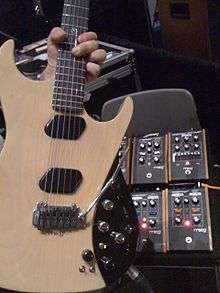Moog Guitar
The Moog Guitar is an electric guitar developed in 2008 by Paul Vo that controls the level of energy within the strings of the guitar to modify the capabilities of the guitar. The guitar can send energy into strings to allow for infinite note sustain or the guitar can pull energy from the strings to create a short, staccato sound. The guitar also possesses harmonic blend control, allowing for new types of guitar harmonics to come out of the instrument. Unlike other technologies that help a guitar sustain notes, the Moog Guitar is unique as it is able to sustain notes on all six strings at once.[1][2]
History
Paul Vo's inspiration came from the futuristic sounds Jimi Hendrix created by exploring the guitar's acoustic properties. Since its release at the summer NAMM show in 2008, the guitar has been used by Joey Santiago, Lou Reed, Daft Punk, Trent Reznor,[2] Kaki King and Fareed Haque. It continues to turn up on various recordings such as the Paul Simon CD "So Beautiful So What" and Brian Eno's LUX.
Features
Full Sustain Mode
This feature allows the guitar to infinitely sustain notes at any volume, at any string, and at any fret position.
Mute Mode
Contrary to full sustain mode, this feature removes the sustain from every note to create a unique staccato sound.
Controlled Sustain Mode
This feature combines both full sustain mode and mute mode to sustain the notes being played and mute the strings that are not being played.
Harmonic Blending
This feature involves using a foot pedal to shift between full sustain mode and mute mode, allowing for the playing of unique harmonic sounds that would otherwise not be possible with the conventional techniques of creating natural or artificial harmonics.
Moog Filter
This feature allows the frequency of the guitar's outputs to be toggled to create additional unique sounds.[3]
Design

The variety of the Moog Guitar's features are a product of its on-board circuitry. The guitar is outfitted with two custom Moog pickups. In addition, the guitar features piezo saddles in the bridge that use piezoelectric sensors to pick up sounds acoustically and with less feedback than conventional pickups. The Moog pickups hold the guitar's ability to control the levels of energy within each string. Within these pickups are six separate transducers that feed energy back into the strings magnetically. Although standard strings work with the guitar, Moog provides stings with a different magnetic make-up to facilitate the guitar's ability to control string energy levels.[4]
The guitar features five knobs and three switches. The Vo Power knob controls the intensity of sustain and mute while the harmonic balance knob controls the balance of sustain and mute between the bridge and the neck. Additionally, the guitar offers a knob for piezo blend that combines the piezo bridge pick-up signal into the guitar's output signal. The last two knobs are conventional volume and tone knobs. The mode selector switch switches between full sustain, mute, and controlled sustain mode while the filter toggle switch controls the articulation of the Moog Filter. Last of all, the guitar features a conventional five position pick-up selector.[3]
Commendations
- Guitar Player Magazine's 2009 Reader's Choice Award
- Electronic Musician Magazine's 2009 Editor's Choice Award
- 2008 Summer NAMM "Best In Show"
- 2008 “Best of What’s New Award” from Popular Science Magazine
- 2009 Mix Foundation TEC Award[5]
Models

- Moog Guitar Model E1 - Black
- Moog Guitar Model E1 - Red
- Moog Guitar Model E1 - Butterscotch
- Moog Lap Steel
- Paul Vo Collector's Edition[5]
References
- ↑ Kobrin, Mike. "Guitar's New Hero". Popular Science. Popular Science. Retrieved 7 February 2012.
- 1 2 McNamee, David (16 November 2009). "Hey, what's that sound: Moog guitar". theguardian. Retrieved 14 February 2012.
- 1 2 Van Buskirk, Eliot (10 June 2008). "Moog Unveils Badass Guitar with Infinite Sustain". Listening Post. Listening Post. Retrieved 7 February 2012.
- ↑ White, Paul. "Moog Guitar Electric guitar-filtering-infinite sustain". Sound on Sound. Sound on Sound. Retrieved 7 February 2012.
- 1 2 "Moog Guitars". Moog Music Inc. Retrieved 14 February 2012.
External links
![]() Media related to Moog Guitar at Wikimedia Commons
Media related to Moog Guitar at Wikimedia Commons